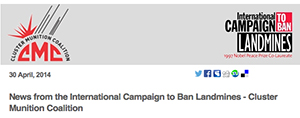05 July 2010
ICBL Statement on Transparency Reporting
Intersessional Standing Committees Meetings, Standing Committee on the General Status and Operation of the Convention, 21 June 2010
Thank you Mr. Chair and thanks also to Belgium for chairing the Article 7 Contact Group. Submitting annual Article 7 transparency reports is a legal obligation, and one that is necessary to help measure the successful implementation of the Convention and the Cartagena Action Plan.
Each year, Article 7 reports are due on 30 April, and each year, fewer States submit their reports, and many are submitted late. As of 21 June, only 45% of States Parties had submitted reports for calendar year 2009. We appear headed to the lowest annual compliance rate in the past decade.
More disturbingly, of the 84 States Parties that have not submitted a report for 2009, many have not submitted an annual transparency report for two or more years. Twenty-one States have not submitted a report since 2004. These facts are detailed in a Landmine and Cluster Munition Monitor Fact Sheet available outside the plenary room.
We are particularly concerned that some affected States have not submitted Article 7 reports for 2009, and some States have submitted reports with insufficient detail. We would like to commend those States that have submitted regular, detailed reports, including States not Party that have provided voluntary transparency reports. For many States, preparing and submitting Article 7 reports should not be a difficult or time consuming task. It may simply involve selecting "unchanged" or "not applicable" for some items on the report's cover sheet.
Last December in Cartagena, States Parties committed themselves to a pragmatic plan to ensure the Convention's full implementation, and the Cartagena Action Plan re-committed States Parties to their legal reporting obligations under the Mine Ban Treaty. We would like to highlight a few points.
In accordance with Action #28 of the Cartagena Action Plan, Form J should be used to report on progress in implementing victim assistance and integrating it into broader national policies, plans, and legal frameworks. Form J is also a tool for States to use to report on both monetary and in-kind cooperation and assistance provided to affected states, as well as national contributions to mine action.
In accordance with Action #12, we would like to see States utilize amended Form B and Form G to report on previously unknown stockpiles of antipersonnel mines. In accordance with Action #11, full and detailed reporting on progress made in stockpile destruction should be included in each annual report. In the Convention's spirit of openness, States are asked to voluntarily report on any foreign stockpiles of antipersonnel mines on territory under their jurisdiction or control. Many States continue to retain mines for research and training purposes, and should be reporting on the intended purposes and actual uses of these mines using expanded Form D.
Action #14 of the Cartagena Action Plan calls for States Parties to share information about the location of known or suspected mined areas, and Action #17 calls for reporting on the number, location, and size of mined areas, clearance plans, and challenges faced in the clearance process. This reporting can be done by using Form C. The Article 7 reporting form is a guide, and States should not feel restricted to the form's template.
Form J allows States Parties flexibility to report on issues not covered elsewhere. For example, States Parties can use Form J to report on steps to ensure that Claymore-type mines and OZM-72 mines are used only in command-detonated mode. Transparency reports should not create undue burden on States, and should not cause reporting fatigue. Annual reports are a way to celebrate progress, to highlight achievements, to re-focus attention on the work ahead, and seek international assistance to get the job done.
Thank you.


